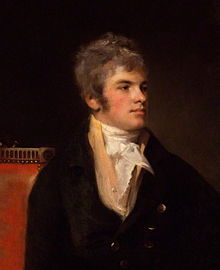Henry Petty-Fitzmaurice, 3rd Marquess of Lansdowne
Henry Petty-Fitzmaurice, 3rd Marquess of Lansdowne KG PC FRS (born July 2, 1780 in Lansdowne House , London , † January 31, 1863 in Bowood House , Wiltshire , England ) was a British statesman .
biography
He was born Henry Petty and was the second of three children of William Petty, 1st Marquess of Lansdowne (1737-1805) and his second wife, Lady Louisa FitzPatrick (1755-1799), a daughter of John FitzPatrick, 1st Earl of Upper Ossory . In 1801 he graduated from the Trinity College of the University of Cambridge as a Master of Arts from.
1802 was first elected as a member of the House of Commons . From 1802 to 1806 he was an MP for the Calne constituency, 1806-1807 for the University of Cambridge and 1807-1809 for Camelford . In 1805 he was one of the leading critics of the First Lord of the Admiralty , Henry Dundas , who was suspected of having embezzled funds during his tenure as Treasurer of the Royal Navy . In February 1806 he was appointed Chancellor of the Exchequer in his cabinet by Prime Minister William Grenville and held this office until March 1807. When his half-brother John Petty, 2nd Marquess of Lansdowne died , he succeeded him as 3rd Marquess of Lansdowne in 1809 . He became a member of the House of Lords and resigned from the House of Commons.
In 1818 he inherited from his childless second degree uncle, Francis Thomas-Fitzmaurice, 3rd Earl of Kerry (1740-1818), the title of 4th Earl of Kerry and then added his family name to "Petty-FitzMaurice".
He was considered a Liberal ( Whig ) and in July 1827 was Minister of the Interior in the cabinet of George Canning . He was then from 1829 to 1831 rector of the University of Glasgow . Between November 1830 and 1834 he was Lord President of the Council in the cabinets of Charles Gray and William Lamb and in this capacity was jointly responsible for the adoption of the electoral reform of 1832 .
After a brief hiatus, he was again Lord President of the Council in the Cabinet of Prime Minister William Lamb in April 1835 and held this office until August 1841. For his services he was accepted into the Order of the Garter in 1836 as a Knight Companion .
In June 1846 he was again appointed Lord President of the Council by Prime Minister John Russell and this time also took over the office of Leader of the House of Lords until February 1852 . Both in February 1852 and in February 1855 he refused to form a government and thus renounced the office of Prime Minister.
The Marquess of Lansdowne was also interested in art and literature and had the Lansdowne Monument built near the Cherhill White Horse in 1845 in memory of his ancestors .
literature
- Una McGovern: Chambers Biographical Encyclopedia. Chambers, Edinburgh 2002, ISBN 0550100512 , p. 890.
Web links
- Henry Petty-FitzMaurice, 3rd Marquess of Lansdowne on thepeerage.com
- Lord Henry Petty in the Hansard (English)
| predecessor | Office | successor |
|---|---|---|
| William Pitt the Younger |
Chancellor of the Exchequer 1806–1807 |
Spencer Perceval |
| William Sturges Bourne |
Minister of the Interior 1827–1828 |
Robert Peel |
| George Herbert |
Lord Lieutenant of Wiltshire 1827–1863 |
George Brudenell-Bruce |
| Henry Bathurst |
Lord President of the Council 1830-1834 |
James St Clair-Erskine |
| James St Clair-Erskine | Lord President of the Council 1835-1841 |
James Stuart-Wortley |
| Walter Montagu Douglas Scott | Lord President of the Council 1846-1852 |
William Lowther |
| John Petty |
Marquess of Lansdowne 1809-1863 |
Henry Petty-Fitzmaurice |
| Francis Thomas-Fitzmaurice |
Earl of Kerry 1818-1863 |
Henry Petty-Fitzmaurice |
| personal data | |
|---|---|
| SURNAME | Petty-Fitzmaurice, Henry, 3rd Marquess of Lansdowne |
| ALTERNATIVE NAMES | Petty, Henry, 3rd Marquess of Lansdowne |
| BRIEF DESCRIPTION | British statesman |
| DATE OF BIRTH | July 2, 1780 |
| PLACE OF BIRTH | Lansdowne House , London |
| DATE OF DEATH | January 31, 1863 |
| Place of death | Bowood House , Wiltshire , England |
